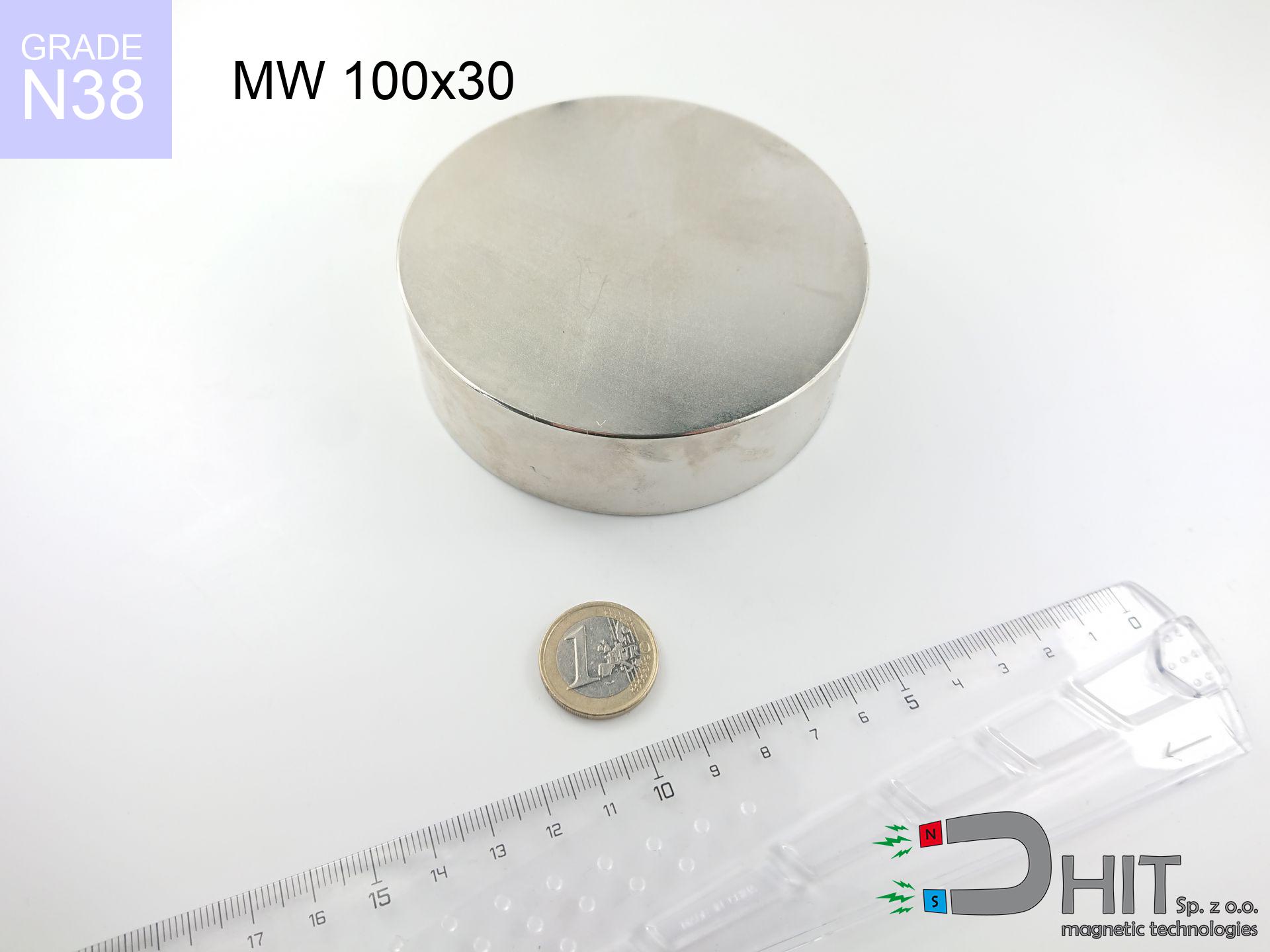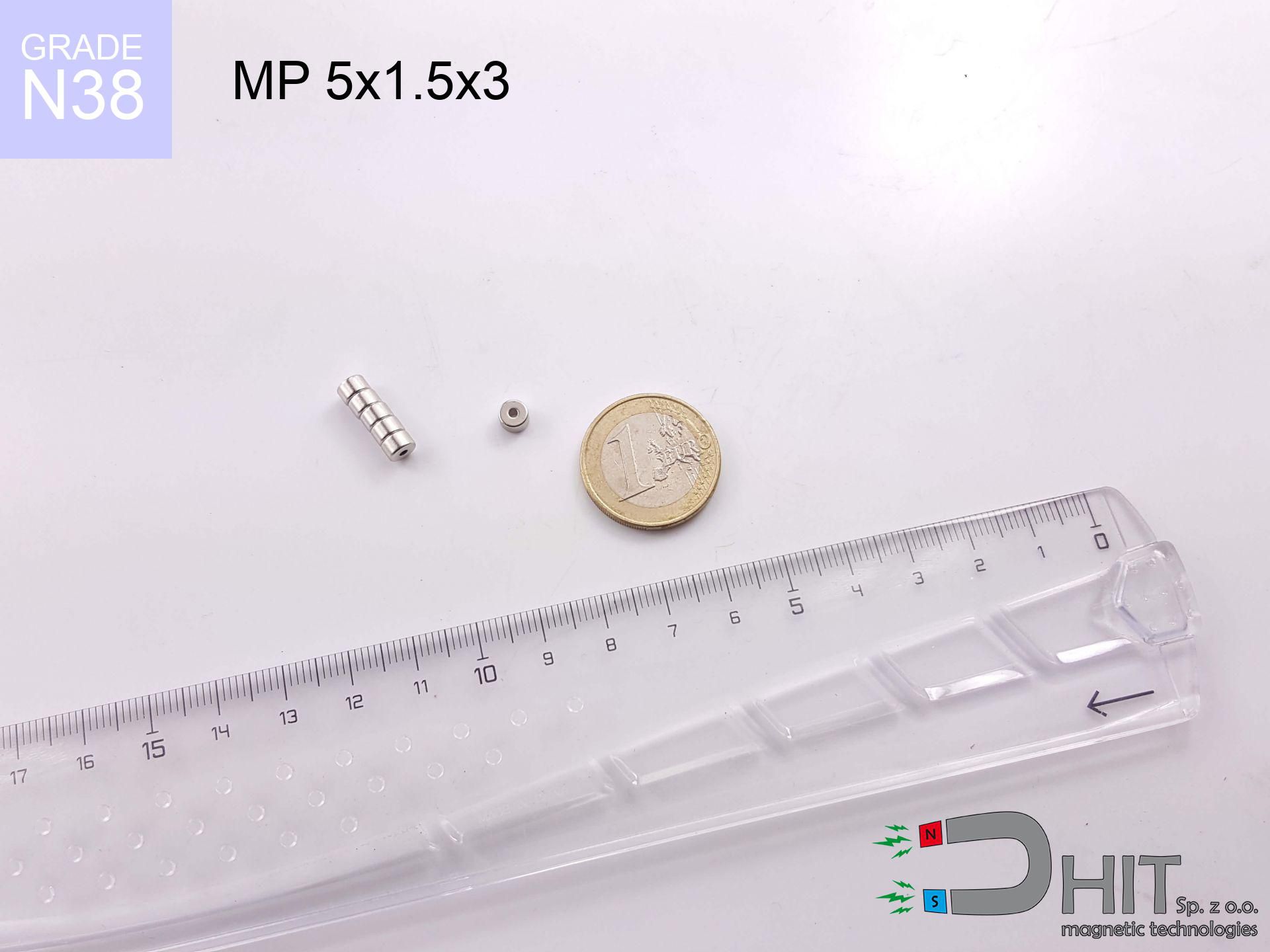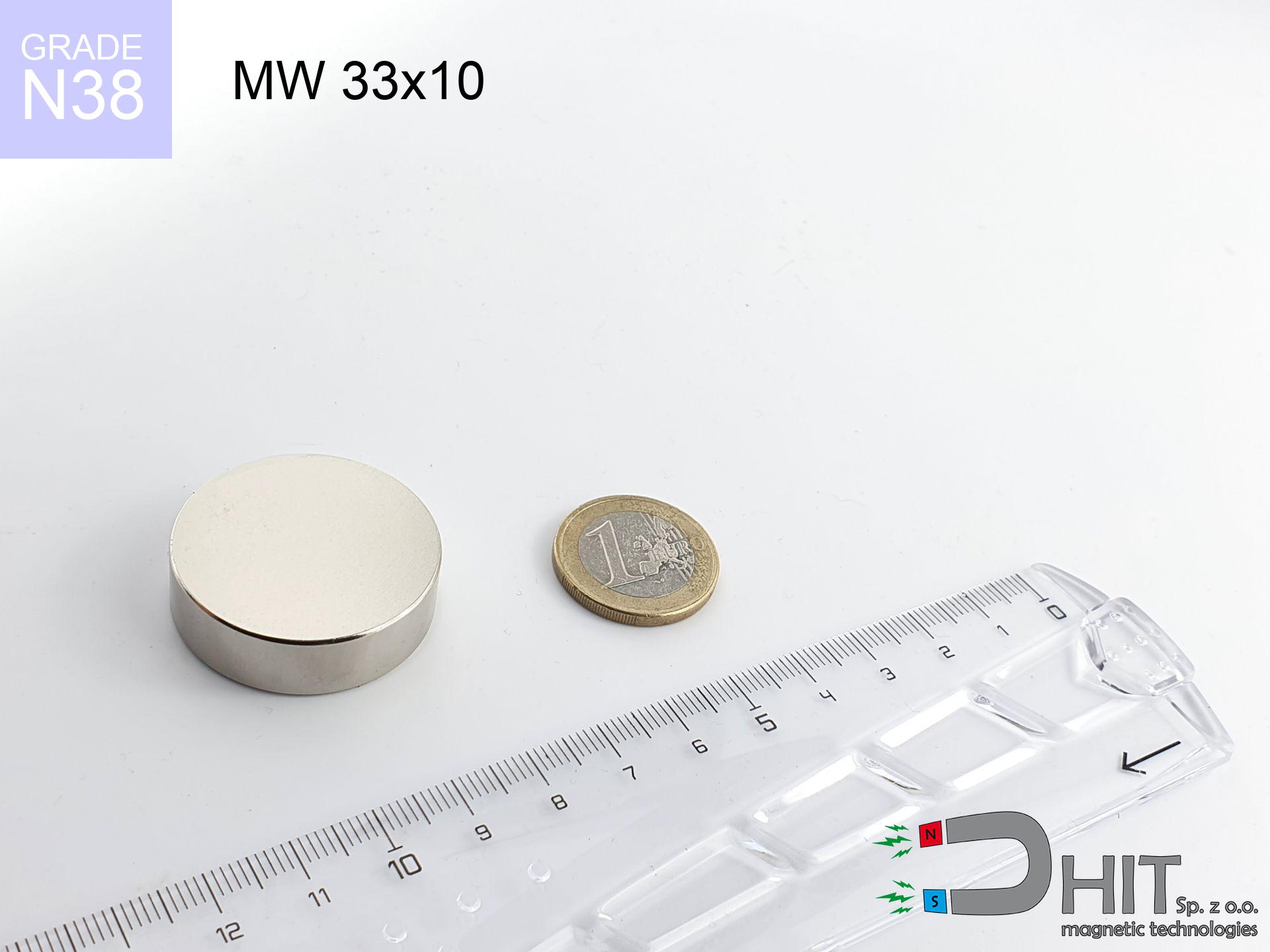MW 100x30 / N38 - cylindrical magnet
cylindrical magnet
Catalog no 010002
GTIN/EAN: 5906301810025
Diameter Ø
100 mm [±0,1 mm]
Height
30 mm [±0,1 mm]
Weight
1767.15 g
Magnetization Direction
↑ axial
Load capacity
215.17 kg / 2110.78 N
Magnetic Induction
318.96 mT / 3190 Gs
Coating
[NiCuNi] Nickel
650.01 ZŁ with VAT / pcs + price for transport
528.46 ZŁ net + 23% VAT / pcs
bulk discounts:
Need more?
Pick up the phone and ask
+48 22 499 98 98
or send us a note through
request form
the contact page.
Lifting power along with appearance of magnets can be verified using our
modular calculator.
Same-day shipping for orders placed before 14:00.
Technical of the product - MW 100x30 / N38 - cylindrical magnet
Specification / characteristics - MW 100x30 / N38 - cylindrical magnet
| properties | values |
|---|---|
| Cat. no. | 010002 |
| GTIN/EAN | 5906301810025 |
| Production/Distribution | Dhit sp. z o.o. |
| Country of origin | Poland / China / Germany |
| Customs code | 85059029 |
| Diameter Ø | 100 mm [±0,1 mm] |
| Height | 30 mm [±0,1 mm] |
| Weight | 1767.15 g |
| Magnetization Direction | ↑ axial |
| Load capacity ~ ? | 215.17 kg / 2110.78 N |
| Magnetic Induction ~ ? | 318.96 mT / 3190 Gs |
| Coating | [NiCuNi] Nickel |
| Manufacturing Tolerance | ±0.1 mm |
Magnetic properties of material N38
| properties | values | units |
|---|---|---|
| remenance Br [min. - max.] ? | 12.2-12.6 | kGs |
| remenance Br [min. - max.] ? | 1220-1260 | mT |
| coercivity bHc ? | 10.8-11.5 | kOe |
| coercivity bHc ? | 860-915 | kA/m |
| actual internal force iHc | ≥ 12 | kOe |
| actual internal force iHc | ≥ 955 | kA/m |
| energy density [min. - max.] ? | 36-38 | BH max MGOe |
| energy density [min. - max.] ? | 287-303 | BH max KJ/m |
| max. temperature ? | ≤ 80 | °C |
Physical properties of sintered neodymium magnets Nd2Fe14B at 20°C
| properties | values | units |
|---|---|---|
| Vickers hardness | ≥550 | Hv |
| Density | ≥7.4 | g/cm3 |
| Curie Temperature TC | 312 - 380 | °C |
| Curie Temperature TF | 593 - 716 | °F |
| Specific resistance | 150 | μΩ⋅cm |
| Bending strength | 250 | MPa |
| Compressive strength | 1000~1100 | MPa |
| Thermal expansion parallel (∥) to orientation (M) | (3-4) x 10-6 | °C-1 |
| Thermal expansion perpendicular (⊥) to orientation (M) | -(1-3) x 10-6 | °C-1 |
| Young's modulus | 1.7 x 104 | kg/mm² |
Engineering modeling of the assembly - technical parameters
The following data are the direct effect of a physical simulation. Values were calculated on models for the material Nd2Fe14B. Operational parameters might slightly differ from theoretical values. Please consider these calculations as a preliminary roadmap during assembly planning.
Table 1: Static pull force (force vs gap) - power drop
MW 100x30 / N38
| Distance (mm) | Induction (Gauss) / mT | Pull Force (kg) | Risk Status |
|---|---|---|---|
| 0 mm |
3189 Gs
318.9 mT
|
215.17 kg / 215170.0 g
2110.8 N
|
crushing |
| 1 mm |
3143 Gs
314.3 mT
|
208.96 kg / 208959.6 g
2049.9 N
|
crushing |
| 2 mm |
3094 Gs
309.4 mT
|
202.53 kg / 202531.7 g
1986.8 N
|
crushing |
| 3 mm |
3044 Gs
304.4 mT
|
195.98 kg / 195982.5 g
1922.6 N
|
crushing |
| 5 mm |
2939 Gs
293.9 mT
|
182.65 kg / 182651.7 g
1791.8 N
|
crushing |
| 10 mm |
2657 Gs
265.7 mT
|
149.35 kg / 149349.8 g
1465.1 N
|
crushing |
| 15 mm |
2366 Gs
236.6 mT
|
118.41 kg / 118412.6 g
1161.6 N
|
crushing |
| 20 mm |
2081 Gs
208.1 mT
|
91.64 kg / 91640.5 g
899.0 N
|
crushing |
| 30 mm |
1573 Gs
157.3 mT
|
52.34 kg / 52344.5 g
513.5 N
|
crushing |
| 50 mm |
874 Gs
87.4 mT
|
16.14 kg / 16140.3 g
158.3 N
|
crushing |
Table 2: Slippage hold (wall)
MW 100x30 / N38
| Distance (mm) | Friction coefficient | Pull Force (kg) |
|---|---|---|
| 0 mm | Stal (~0.2) |
43.03 kg / 43034.0 g
422.2 N
|
| 1 mm | Stal (~0.2) |
41.79 kg / 41792.0 g
410.0 N
|
| 2 mm | Stal (~0.2) |
40.51 kg / 40506.0 g
397.4 N
|
| 3 mm | Stal (~0.2) |
39.20 kg / 39196.0 g
384.5 N
|
| 5 mm | Stal (~0.2) |
36.53 kg / 36530.0 g
358.4 N
|
| 10 mm | Stal (~0.2) |
29.87 kg / 29870.0 g
293.0 N
|
| 15 mm | Stal (~0.2) |
23.68 kg / 23682.0 g
232.3 N
|
| 20 mm | Stal (~0.2) |
18.33 kg / 18328.0 g
179.8 N
|
| 30 mm | Stal (~0.2) |
10.47 kg / 10468.0 g
102.7 N
|
| 50 mm | Stal (~0.2) |
3.23 kg / 3228.0 g
31.7 N
|
Table 3: Vertical assembly (shearing) - behavior on slippery surfaces
MW 100x30 / N38
| Surface type | Friction coefficient / % Mocy | Max load (kg) |
|---|---|---|
| Raw steel |
µ = 0.3
30% Nominalnej Siły
|
64.55 kg / 64551.0 g
633.2 N
|
| Painted steel (standard) |
µ = 0.2
20% Nominalnej Siły
|
43.03 kg / 43034.0 g
422.2 N
|
| Oily/slippery steel |
µ = 0.1
10% Nominalnej Siły
|
21.52 kg / 21517.0 g
211.1 N
|
| Magnet with anti-slip rubber |
µ = 0.5
50% Nominalnej Siły
|
107.59 kg / 107585.0 g
1055.4 N
|
Table 4: Material efficiency (substrate influence) - sheet metal selection
MW 100x30 / N38
| Steel thickness (mm) | % power | Real pull force (kg) |
|---|---|---|
| 0.5 mm |
|
7.17 kg / 7172.3 g
70.4 N
|
| 1 mm |
|
17.93 kg / 17930.8 g
175.9 N
|
| 2 mm |
|
35.86 kg / 35861.7 g
351.8 N
|
| 5 mm |
|
89.65 kg / 89654.2 g
879.5 N
|
| 10 mm |
|
179.31 kg / 179308.3 g
1759.0 N
|
Table 5: Thermal resistance (stability) - thermal limit
MW 100x30 / N38
| Ambient temp. (°C) | Power loss | Remaining pull | Status |
|---|---|---|---|
| 20 °C | 0.0% |
215.17 kg / 215170.0 g
2110.8 N
|
OK |
| 40 °C | -2.2% |
210.44 kg / 210436.3 g
2064.4 N
|
OK |
| 60 °C | -4.4% |
205.70 kg / 205702.5 g
2017.9 N
|
|
| 80 °C | -6.6% |
200.97 kg / 200968.8 g
1971.5 N
|
|
| 100 °C | -28.8% |
153.20 kg / 153201.0 g
1502.9 N
|
Table 6: Magnet-Magnet interaction (repulsion) - field collision
MW 100x30 / N38
| Gap (mm) | Attraction (kg) (N-S) | Repulsion (kg) (N-N) |
|---|---|---|
| 0 mm |
492.55 kg / 492546 g
4831.9 N
4 762 Gs
|
N/A |
| 1 mm |
485.56 kg / 485558 g
4763.3 N
6 333 Gs
|
437.00 kg / 437002 g
4287.0 N
~0 Gs
|
| 2 mm |
478.33 kg / 478330 g
4692.4 N
6 286 Gs
|
430.50 kg / 430497 g
4223.2 N
~0 Gs
|
| 3 mm |
471.01 kg / 471012 g
4620.6 N
6 238 Gs
|
423.91 kg / 423911 g
4158.6 N
~0 Gs
|
| 5 mm |
456.15 kg / 456150 g
4474.8 N
6 139 Gs
|
410.53 kg / 410535 g
4027.3 N
~0 Gs
|
| 10 mm |
418.11 kg / 418108 g
4101.6 N
5 877 Gs
|
376.30 kg / 376298 g
3691.5 N
~0 Gs
|
| 20 mm |
341.88 kg / 341877 g
3353.8 N
5 314 Gs
|
307.69 kg / 307689 g
3018.4 N
~0 Gs
|
| 50 mm |
159.49 kg / 159489 g
1564.6 N
3 630 Gs
|
143.54 kg / 143541 g
1408.1 N
~0 Gs
|
Table 7: Safety (HSE) (electronics) - warnings
MW 100x30 / N38
| Object / Device | Limit (Gauss) / mT | Safe distance |
|---|---|---|
| Pacemaker | 5 Gs (0.5 mT) | 44.0 cm |
| Hearing aid | 10 Gs (1.0 mT) | 34.5 cm |
| Mechanical watch | 20 Gs (2.0 mT) | 27.0 cm |
| Phone / Smartphone | 40 Gs (4.0 mT) | 21.0 cm |
| Remote | 50 Gs (5.0 mT) | 19.0 cm |
| Payment card | 400 Gs (40.0 mT) | 8.0 cm |
| HDD hard drive | 600 Gs (60.0 mT) | 6.5 cm |
Table 8: Collisions (cracking risk) - collision effects
MW 100x30 / N38
| Start from (mm) | Speed (km/h) | Energy (J) | Predicted outcome |
|---|---|---|---|
| 10 mm |
15.21 km/h
(4.22 m/s)
|
15.77 J | |
| 30 mm |
22.01 km/h
(6.11 m/s)
|
33.03 J | |
| 50 mm |
26.02 km/h
(7.23 m/s)
|
46.17 J | |
| 100 mm |
35.32 km/h
(9.81 m/s)
|
85.04 J |
Table 9: Coating parameters (durability)
MW 100x30 / N38
| Technical parameter | Value / Description |
|---|---|
| Coating type | [NiCuNi] Nickel |
| Layer structure | Nickel - Copper - Nickel |
| Layer thickness | 10-20 µm |
| Salt spray test (SST) ? | 24 h |
| Recommended environment | Indoors only (dry) |
Table 10: Construction data (Flux)
MW 100x30 / N38
| Parameter | Value | SI Unit / Description |
|---|---|---|
| Magnetic Flux | 269 425 Mx | 2694.3 µWb |
| Pc Coefficient | 0.40 | Low (Flat) |
Table 11: Underwater work (magnet fishing)
MW 100x30 / N38
| Environment | Effective steel pull | Effect |
|---|---|---|
| Air (land) | 215.17 kg | Standard |
| Water (riverbed) |
246.37 kg
(+31.20 kg Buoyancy gain)
|
+14.5% |
1. Vertical hold
*Caution: On a vertical wall, the magnet retains merely a fraction of its max power.
2. Efficiency vs thickness
*Thin metal sheet (e.g. 0.5mm PC case) drastically limits the holding force.
3. Temperature resistance
*For N38 grade, the critical limit is 80°C.
4. Demagnetization curve and operating point (B-H)
chart generated for the permeance coefficient Pc (Permeance Coefficient) = 0.40
This simulation demonstrates the magnetic stability of the selected magnet under specific geometric conditions. The solid red line represents the demagnetization curve (material potential), while the dashed blue line is the load line based on the magnet's geometry. The Pc (Permeance Coefficient), also known as the load line slope, is a dimensionless value that describes the relationship between the magnet's shape and its magnetic stability. The intersection of these two lines (the black dot) is the operating point — it determines the actual magnetic flux density generated by the magnet in this specific configuration. A higher Pc value means the magnet is more 'slender' (tall relative to its area), resulting in a higher operating point and better resistance to irreversible demagnetization caused by external fields or temperature. A value of 0.42 is relatively low (typical for flat magnets), meaning the operating point is closer to the 'knee' of the curve — caution is advised when operating at temperatures near the maximum limit to avoid strength loss.
Elemental analysis
| iron (Fe) | 64% – 68% |
| neodymium (Nd) | 29% – 32% |
| boron (B) | 1.1% – 1.2% |
| dysprosium (Dy) | 0.5% – 2.0% |
| coating (Ni-Cu-Ni) | < 0.05% |
Sustainability
| recyclability (EoL) | 100% |
| recycled raw materials | ~10% (pre-cons) |
| carbon footprint | low / zredukowany |
| waste code (EWC) | 16 02 16 |
Other products
Pros and cons of Nd2Fe14B magnets.
Pros
- They retain magnetic properties for almost ten years – the drop is just ~1% (based on simulations),
- They maintain their magnetic properties even under external field action,
- The use of an aesthetic coating of noble metals (nickel, gold, silver) causes the element to be more visually attractive,
- Magnets are characterized by very high magnetic induction on the active area,
- Thanks to resistance to high temperature, they are capable of working (depending on the shape) even at temperatures up to 230°C and higher...
- Considering the ability of free molding and customization to custom solutions, neodymium magnets can be modeled in a variety of geometric configurations, which increases their versatility,
- Wide application in advanced technology sectors – they are utilized in hard drives, brushless drives, medical devices, also modern systems.
- Thanks to their power density, small magnets offer high operating force, in miniature format,
Disadvantages
- They are fragile upon too strong impacts. To avoid cracks, it is worth securing magnets using a steel holder. Such protection not only shields the magnet but also increases its resistance to damage
- Neodymium magnets lose their strength under the influence of heating. As soon as 80°C is exceeded, many of them start losing their power. Therefore, we recommend our special magnets marked [AH], which maintain durability even at temperatures up to 230°C
- They rust in a humid environment. For use outdoors we suggest using waterproof magnets e.g. in rubber, plastic
- Limited ability of making threads in the magnet and complicated shapes - recommended is a housing - mounting mechanism.
- Potential hazard resulting from small fragments of magnets are risky, when accidentally swallowed, which is particularly important in the context of child safety. It is also worth noting that tiny parts of these products can complicate diagnosis medical in case of swallowing.
- Due to complex production process, their price is relatively high,
Holding force characteristics
Optimal lifting capacity of a neodymium magnet – what it depends on?
- using a base made of high-permeability steel, functioning as a ideal flux conductor
- with a thickness no less than 10 mm
- characterized by lack of roughness
- under conditions of no distance (metal-to-metal)
- during detachment in a direction perpendicular to the plane
- at conditions approx. 20°C
Magnet lifting force in use – key factors
- Air gap (betwixt the magnet and the metal), because even a very small distance (e.g. 0.5 mm) results in a drastic drop in lifting capacity by up to 50% (this also applies to paint, rust or dirt).
- Direction of force – maximum parameter is reached only during perpendicular pulling. The force required to slide of the magnet along the surface is standardly many times lower (approx. 1/5 of the lifting capacity).
- Metal thickness – the thinner the sheet, the weaker the hold. Magnetic flux penetrates through instead of converting into lifting capacity.
- Chemical composition of the base – low-carbon steel gives the best results. Alloy admixtures decrease magnetic properties and lifting capacity.
- Base smoothness – the smoother and more polished the plate, the better the adhesion and stronger the hold. Unevenness acts like micro-gaps.
- Thermal conditions – NdFeB sinters have a negative temperature coefficient. When it is hot they lose power, and in frost gain strength (up to a certain limit).
Lifting capacity was measured by applying a polished steel plate of suitable thickness (min. 20 mm), under perpendicular detachment force, in contrast under shearing force the load capacity is reduced by as much as 75%. Additionally, even a minimal clearance between the magnet and the plate decreases the load capacity.
Precautions when working with NdFeB magnets
Heat warning
Standard neodymium magnets (N-type) lose magnetization when the temperature goes above 80°C. Damage is permanent.
Fire warning
Fire warning: Neodymium dust is highly flammable. Do not process magnets without safety gear as this risks ignition.
Adults only
NdFeB magnets are not toys. Swallowing multiple magnets can lead to them connecting inside the digestive tract, which poses a critical condition and requires urgent medical intervention.
Data carriers
Data protection: Strong magnets can ruin payment cards and delicate electronics (heart implants, hearing aids, timepieces).
Compass and GPS
A strong magnetic field negatively affects the functioning of magnetometers in smartphones and GPS navigation. Maintain magnets near a device to avoid breaking the sensors.
Nickel allergy
It is widely known that nickel (the usual finish) is a common allergen. If you have an allergy, prevent direct skin contact and choose encased magnets.
Eye protection
Beware of splinters. Magnets can fracture upon violent connection, launching shards into the air. Wear goggles.
Bone fractures
Large magnets can crush fingers in a fraction of a second. Never put your hand between two strong magnets.
Immense force
Before starting, read the rules. Sudden snapping can destroy the magnet or hurt your hand. Think ahead.
Life threat
Life threat: Neodymium magnets can deactivate pacemakers and defibrillators. Stay away if you have electronic implants.






![HH 42x8.8 [M6] / N38 - through hole magnetic holder HH 42x8.8 [M6] / N38 - through hole magnetic holder](https://cdn3.dhit.pl/graphics/products/hh-42x8.8-m6-hin.jpg)


